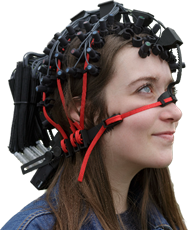fNIRS Optical Brain Imaging
Continuous Wave fNIR Spectroscopy
Affordable Cognitive Assessment
Wearable near-infrared spectroscopy based systems enable the continuous, noninvasive, and safe monitoring of changes in blood oxygenation and blood volume related to human brain function. fNIRS provides real-time monitoring of tissue oxygenation in the brain as participants take tests, perform cognitive tasks, and/or receive stimulation. Wireless and wired solutions are available for adult and pediatric subjects.
The technology empowers researchers by providing greater flexibility for real-life study design, including working within complex lab environments and deploying in various field settings such as, operating room, classroom, cockpit, control stations, training simulators, etc.
Integrate with physiological and neurobehavioral measures, stimulus presentation, and virtual reality products for comprehensive protocols to quantitatively assess brain functions, including but not limited to attention, working memory, planning, decision making, problem solving, etc. while individuals perform cognitive tasks.
 Whole-head fNIRS + EEG Systems
Whole-head fNIRS + EEG Systems
NEW! MedelOpt® Systems use a groundbreaking wearable neuroimaging device to deliver high-density, whole-head functional neuroimaging (fNIRS) with electroencephalogram (EEG) for real-time noninvasive measurement and recording of brain activity. Designed by researchers for researchers, MedelOpt patented functional neuroimaging devices are ideal for psychological studies, sports science, and a comprehensive range of neurodevelopmental research, for both first-time users and research centers with expertise in these procedures.
 Prefrontal Cortex fNIRS
Prefrontal Cortex fNIRS
fNIR Imager Systems utilize an fNIRS sensor (IR light sources and detectors mounted in a flexible band) that participants wear on the forehead. It detects oxygen levels in the prefrontal cortex and provides real-time values for oxy-hemoglobin and deoxygenated hemoglobin. fNIRS sensors can also be used in muscle activation studies to increase understanding of underlying control mechanisms that couple oxygen delivery to oxidative metabolism.
Stay Connected